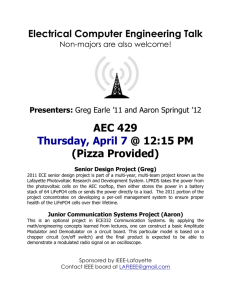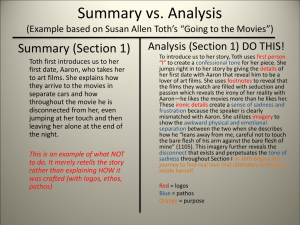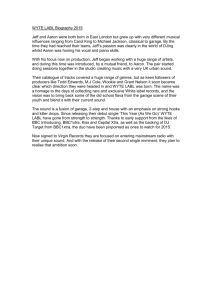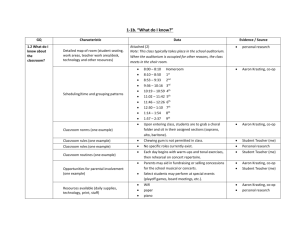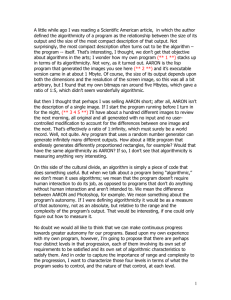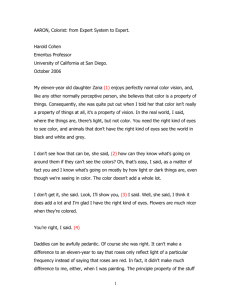I used to judge the progress of the computer revolution by the
advertisement
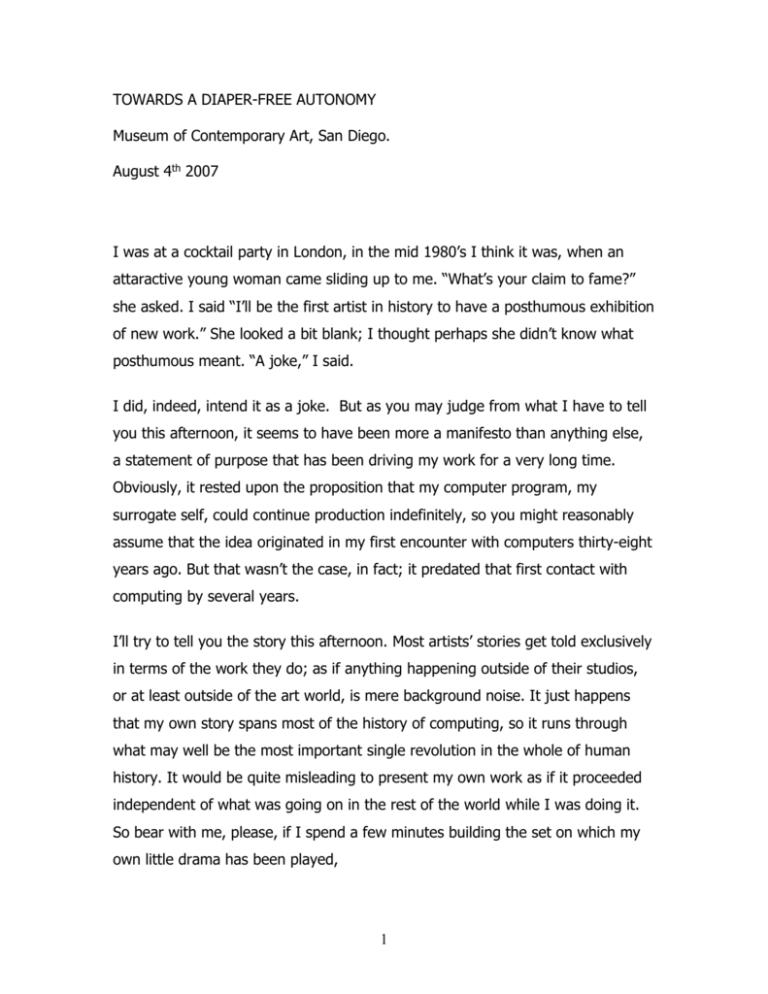
TOWARDS A DIAPER-FREE AUTONOMY Museum of Contemporary Art, San Diego. August 4th 2007 I was at a cocktail party in London, in the mid 1980’s I think it was, when an attaractive young woman came sliding up to me. “What’s your claim to fame?” she asked. I said “I’ll be the first artist in history to have a posthumous exhibition of new work.” She looked a bit blank; I thought perhaps she didn’t know what posthumous meant. “A joke,” I said. I did, indeed, intend it as a joke. But as you may judge from what I have to tell you this afternoon, it seems to have been more a manifesto than anything else, a statement of purpose that has been driving my work for a very long time. Obviously, it rested upon the proposition that my computer program, my surrogate self, could continue production indefinitely, so you might reasonably assume that the idea originated in my first encounter with computers thirty-eight years ago. But that wasn’t the case, in fact; it predated that first contact with computing by several years. I’ll try to tell you the story this afternoon. Most artists’ stories get told exclusively in terms of the work they do; as if anything happening outside of their studios, or at least outside of the art world, is mere background noise. It just happens that my own story spans most of the history of computing, so it runs through what may well be the most important single revolution in the whole of human history. It would be quite misleading to present my own work as if it proceeded independent of what was going on in the rest of the world while I was doing it. So bear with me, please, if I spend a few minutes building the set on which my own little drama has been played, 1 I met my first computer at the end of 1968, when I came to UCSD from London on a one year visiting professorship. Or, to be more precise, it only started out as a one-year visit – I’ve been here ever since – and I didn’t actually meet the computer, because it was a room-sized facility locked away from mere users and served by a staff of high priests, whose understanding was that the computer was there to serve the needs of scientists. They never did understand why I was using it to make curious, pointless freehand-looking drawings instead of the graphs their single printer usually made. Very few people outside the universities had much of a clue about computers at that point, but that was clearly changing, and I could track the progress of the revolution, roughly, by the number of people I would hear talking about their new computers in restaurants. But it wasn’t long before nobody in restaurants seemed to be talking about anything else. The revolution was in full swing. But it wasn’t really the revolution I thought I was marching in. What I was witnessing was the American genius for turning anything into a mass-marketable commodity; turning its attention, finally, to the computer. I worked on the University’s central computing system for several years, joining the small band of people who worked all night in order to get immediate turnaround on their jobs. If you submitted a job during normal working hours you might not get the output back for a couple of days. I even got invited into the inner sanctum, where I saw the first disk drives installed – about as big as washing machines, they were, with gigantic disks stacked up one atop the other – the operator would ram a folded-up newspaper between the platters to clean them if the machine was making mistakes -- but I don’t recall why I was afforded the privilege. But I still had the habits of mind of a 20-year career as an artist, and it was clear that I couldn’t borrow the University’s computer to do shows. The industry, and 2 the University’s research committee, came to my rescue. I was given a research grant of around $12,000, which bought me a Nova computer – what was then called a mini-computer; one of the first machines designed to venture into the mass market – and a Tektronix display, a fair-sized floor model with a tiny screen, on which a bright green dot would dance around, leaving a rather less bright green line. [ 1 ] For those of you who were not around thirty-nine years ago it’s difficult to get a picture of what computing was like in those early days. In fact, it’s quite hard to recall the flavor of what it had been like even if you had been there. My little Nova had all of 8k of core memory; -- literally core memory, with fine wires threaded through the tiny ferrite cores – and it could run Basic, which had to be loaded off paper tape. Paper tape was its only mass storage. Unlikely as it seems now, looking back, I did, in fact, do two museum shows – one at the LA County Museum -- with my little Nova, which not only generated drawings but also controlled a drawing machine I’d built. Hard to imagine such a setup, from the view of computing we have today. The best measure of the difference in power between then and now is given in what has come to be known as Moore’s Law; which everyone quotes and which says that computing power per unit cost has been doubling roughly every eighteen months. But I always think that Moore’s Law somehow masks the true drama of the machine’s development by what sounds like a modest enough rate of development, expressed as it is it in small numbers. Let me see if I can give you a more graphic sense of what Moore’s law actually means. Thirty-nine years is thirteen three-year periods, or twenty-six eighteen month doublings. Two raised to the 26th power comes out at – what? can it be possible? – 67,108,864. [ 2 ] Out of little acorns mighty oaks do grow, they say. But did any mighty oak ever grow to be sixty-seven million times as big as the acorn? The biggest tree I’ve ever seen isn’t an oak, of course, it’s a sequoia, the 3 Sherman tree, [ 3 ] which holds the record at 52,500 cu ft. I don’t really know how big a sequoia seed is – they’re quite tiny, much smaller than acorns -- but IF you could pack roughly thirteen hundred of them into a one cu ft box, and IF the Sherman tree had grown to its present size in thirty-nine years – it didn’t, of course, by a factor of ten, at least -- it would match Moore’s Law. (arithmetic: (expt 2 26)/ 52500 = 1278.264) I’m asked quite frequently whether I had in mind to do what you see in this exhibition when I started using the computer. And I have to explain that I could not possibly have had it in mind, considering what computers were at that time. Try working back; what would one 67millionth of your PC be able to do for you? Of course there was a cost attached to entering the mass market; the market is not full of people who want to do anything as esoteric as learning to program. There has to be a great deal of dumbing down of any product before you can reach everyone who has two thousand dollars to spend on a new toy. As George Eastman had realized a hundred years earlier, when he launched Kodak, he had to provide, or at least claim to provide, a fool-proof system. There weren’t enough professional photographers around to make Kodak a success, but given his fool-proof system any fool could take a photograph. And there never have been enough sophisticated computer folk, ready to write their own programs, to bring the cost of the machine down to $2000. Eastman’s marketing slogan – “you press the button, we do the rest” – could almost serve as a mantra for the mass marketing of computers. We’ve simply substituted “user-friendly” for “foolproof.” As an article in London’s Telegraph announced just a few days ago: “An overreliance on technology is leading to a dumbing down of the nation’s brain power” [ 4] 4 The cost, then, has to be measured in terms of the user’s new expectations concerning his own role: he just presses the button and the computer does all the rest: he doesn’t need to know anything in order to write letters, or do his taxes, or make art or write poetry. But I’d been one of the fortunate few who came to computing before the dumbing down had started, and though I remained one of the very few who chose to have the computer make art, the two years I spent as a guest at the Artificial Intelligence lab at Stanford made me aware that computers were being used to do all kinds of things that didn’t fit the “computers are for physicists” model. The lab was full of people writing programs to generate music, clean up old Caruso recordings, do medical diagnoses, control the vending machine, play chess. You name it; the general belief in that environment was that you could have the machine do anything you could write a program for. It’s no surprise, then, that when I returned to UCSD and initiated computing into the curriculum of the Visual Art Department, I took the position -- which I still hold, even more strongly – that, just as drawing had always been regarded as the fundamental discipline of painting, programming was the fundamental discipline of computing. And programming was what I taught. For a short while it was well received; but the day came when students would tell me “we don’t want to learn programming, we just want to know how to use Photoshop.” “Photoshop,” I’d say,” you don’t need a university course to learn how to use Photoshop; you just read the manual and poke around a bit.” But the writing was on the wall and it was my good fortune that I was able to retire from teaching not long afterwards. So the computer revolution developed a more complex profile in the ensuing years. On the one hand we have the growing power of the machine, giving essential support to a number of new revolutions: in genetics, weather forecasting, astronomy, medicine – none of which would have been possible 5 without the computer; -- go into the basement of any modern hospital and open any door and you’ll find highly specialized, computer enabled machines to do things you can hardly imagine; I had one produce a cross-section of my retina. And, in parallel, we have a ceaseless effort to make each new innovation serve the mass market. For the most part, and given the know-nothing approach propagated along with the mass-market computer, the artist has found himself on the consumer side of the profile. Computing, where it has figured at all in the art schools, has given way to multi-media programs, in which the computer figures as simply another piece of technological raw material; or at best as a black box for running programs that the individual didn’t write. I don’t know of more than half-a-dozen art departments and schools worldwide where computer programming is being taught today as a regular, much less a mandatory, discipline. You don’t need me to tell you that we live in an age and in a culture dominated by technology. And there is every indication that the rate of technological growth is increasing, probably exponentially. But most of what information reaches the consumer public has to do with the things designed for the consumer. Consider the cell-phone, for example, which has been around for what -- a decade? -- and now there are more cell-phones in circulation than personal computers. They aren’t being given low-resolution digital cameras to satisfy any deep scientific purpose. For that matter, the physics of the charge-coupled device that makes the digital camera possible wasn’t developed so that people could fill up their computer’s disk-drives with thousands of holiday snapshots they would never look at. If you want to know how much effort is going on today in innovative research, and how much of it is going into bringing the products of that research to market, you can do a lot worse than visit a site which collects together much of 6 the reporting in the various media about what’s going on in the world of science and technology. I happen to use the Kurzweil-AI site, and I made a point of rereading all 92 of last month’s entries in preparation for this talk, thinking that I’d be able to separate the science from the applications. I couldn’t. Technology – which is a term you’d rarely have heard fifty years ago – has come to mean, essentially, the business of turning science into applications, and the reports I read that did not deal directly with applications made a point of listing the possible applications for what would have been regarded as pure science fifty years ago.. All the same, the numbers were quite revealing: more than a third of the total were on computers, AI and Robotics. I had to lump them together, because it’s clear that a major breakthrough in one area could, and most certainly would, be applied in as many applications as the researcher, or his targeted funding agencies, could imagine. Not surprisingly, much of the research in these areas is being paid for by NASA and by the military. Their motives are clear: it’s no fun spending huge sums of money sending exploratory vehicles to Mars and then having one of them fall in a hole. It takes much too long to send a video of the terrain to a controller on earth and have him send back instructions for avoiding the hole, so there is a need for your vehicle to be smart enough, autonomous enough, to find its own safe path around the hole. Of course, any astute entrepreneur will quickly catch on to the fact that finding a path around a hole has a lot in common with finding a path around the living room table. On the consumer side the motives are what they have always been, but the needs may not come into focus until they are invented, or spotted, by the 7 entrepreneurs who see a way of satisfying their profit motives by satisfying those needs. Who knew they needed cell-phones before Nokia started making them? Of course, we did know that some old people need to be looked after – that need was spotted, not invented -- and there’s a good deal of research today driven by the idea that robots can be used to look after them. It is assumed that to be acceptable to their wards, robots have to look warm and friendly; to look and act as much like people as possible. Now, it may be that some of the researchers involved had other, simpler motives – the 21st century version of the Pygmalion myth. But nobody funding their research seem also to have funded research to discover whether old people will really be more comfortable with their robot caregivers if they look and act human or if they look like the machines they are. If it’s really the case that a third of all research is currently devoted to computers, AI and robotics, then we are evidently in the opening stages of the robotic age. And whether R2D2 or 3CPIO prove to be the better model, you don’t need a crystal ball to guess that we’ll be seeing an increasing number of artists turning to robotic art of one sort or another in the next five or ten years. We’re already seeing some. It’s also a pretty safe bet that for the most part they’ll be using off-the-shelf robots; that the “art” will be manifested in dreaming up contexts they were never intended for; and the culture’s definitions of art will change accordingly. Well, artists have been building and using machines for quite a while now. I can remember seeing an enchanting exhibition of Tinguely’s drawing machines in New York almost fifty years ago. What’s the difference between a robot and any other sophisticated machine? People in the field say that to qualify as a robot, a machine must be able to sense its environment and be responsive to it; and it must have a physical body 8 through which to experience the world. There’s nothing in their definitions about having to be humanoid in appearance; that belongs on the consumer side. Or, to put it more simply, whatever its shape, size or appearance, for a machine to be a robot it must have its own intelligence controlling its own actions. To say that we’re entering the age of robotics is to say we’re entering the age of autonomous machines. Hold on, though! That’s exactly the notion I said had been driving my own work for a very long time. As I said, I met – or didn’t meet -- my first computer in the fall of 1968, when I came to San Diego from London on a one-year visiting professorship. But the reasons for living through the challenge of using it had been planted five years before that. [ 5 ] I should explain that my painting at that time involved inventing forms, and presenting them as though they belonged in the real world. [ 6 ] I was enjoying some success, but I was starting to feel very nervous about the limitations my working methods implied; beginning to suspect that one couldn’t go on inventing indefinitely. [ 7 ] Shouldn’t it be possible, I wondered, to write the rules for generating material for a painting and then simply follow the rules? In this way, it would be almost as if the painting was painting itself; and I would be relieved of the uncertain task of inventing on a day-to-day basis. That was a little naïve, of course; it simply shifted the burden of invention to another place, another level. I’m still inventing on a day to day basis, but now it’s likely to be algorithms for doing particular tasks that I’m inventing. By 1966, when I represented the UK in the Venice Biennale, all the paintings I showed had been made under that paradigm. [ 8 ] I would work with the canvas on the floor, start by spattering it with paint in a thoroughly arbitrary fashion, then invent rules for how a line should behave as it meandered through this 9 “terrain.” [ 9 ] I saw the process as analogous to the way water flows through a real, physical terrain, tracing what looks like a random path that is actually tightly controlled by physical laws. And two years later I turned up in San Diego to discover there were machines that could, potentially at least, be given the task of running the program for generating paintings rather than having to act out the rules myself. I’m always aware, telling stories like this one, that one inevitably seems to have been much more aware of the forces at work than had actually been the case at the time. So let me be clear that I didn’t start using the machine because I saw it in the terms I’ve just described. Reading some of the papers I wrote at the time, I see that I started using it because I was fed up with the London art scene; frustrated with the sense that my work had gone off course somehow; and because I was beginning to suspect that there were more interesting things happening outside my studio than inside my studio. I did not seek programming; the opportunity simply presented itself. And I continued with it principally because I recognized that I was being challenged intellectually in a way I had never been challenged by painting. Nevertheless, and as Pascal so wisely said, fortune favors the prepared mind, and there was no question that my mind was fully prepared. There was also no turning back; if I didn’t know what I was doing or why I was doing it, I recognized, at least, that I was more completely involved in what I was doing than I had been involved in painting. Whether I could focus on it or not; whether I was aware of it as a destination, I came to computing with the idea that a program could generate art. That was 38 years ago. If I can give you a measure of how far I’ve gone on the path to the autonomous program; I start AARON running before I go to bed at night and I have a hundred and fifty originals to review the following morning. [ 10 10 ] I can’t tell you how many it actually makes; it simply stops storing them at 150 because that’s as much as I can handle in the following days while I’m trying to figure out which [ 11 ] ones to print. I usually manage to get the number down to around thirty, and of those thirty I may actually print five or six. The five smaller pieces in the exhibition [ 12 ] were all generated on the same night and I have print files of another dozen or more ready to go. But long before I could get around to printing them [ 13 ] AARON did another night’s work and I have new images to print. Now, 38 years of work is a lot of work, and while AARON’s Odessey might make a fun book if only Homer would get around to writing it, it obviously isn’t suitable for a one-hour talk. Rather than doing a fast, and necessarily superficial, run through of AARON’s output, I think it will be more revealing to give you a more in-depth account of one particular development in AARON’s history. I’m going to talk about AARON’s understanding and use of color. In fact, color has been the central focus of my work since around 1986, when I finally figured out – and here’s a major milepost on the road to program autonomy – that it wouldn’t be possible to get AARON to do its own coloring by simulating the way I did it myself. Why? Because all human colorists depend upon a visual feedback system that allows them to assess the result of one move before deciding on the next move. And they need that feedback, because human beings have a very limited imagination for color. Not even the most expert colorist can plan a complete coloring scheme for a painting and then follow the plan, or have someone else do it, without bothering to look at the painting. Since AARON didn’t have a visual system, there could be no feedback and the fundamentally ad-hoc procedures of the human colorist couldn’t be simulated. It did, however, have what the human colorist lacked; color imagination – or, to 11 put that in rather more technical terms – the ability to build and maintain a flawless internal representation of an arbitrarily complex color scheme. That meant that AARON’s knowledge of how to use color would have to be a rule-based system – that is, a list of rules covering the significant things that could happen as an image developed and what to about them -- in which the program would keep a very complete internal model of which colors were going where. [ 14 ] What followed was nearly twenty years of developing AARON’s rule-base, including a rather lengthy detour in which I built a series of painting machines [ 15 ] that required their own rules for dealing with the dyes I’d selected for it to use. [ 16 ] I abandoned the painting machines eventually in favor of one of the new wide-format printers that were just then coming on the market. [ 17 ] More work on the coloring rules for this new environment; until, finally, AARON’s rule base had become so detailed, so complicated, that I was having a hard time making any changes, adding any new rules, without breaking something in some remote corner of the code that I hadn’t looked at for years. And while I couldn’t see any resolution to the problem of complexity, I concluded eventually that at least part of the problem was the color model I’d chosen. I should explain, for those of you not familiar with the workings of your color monitors, that the face of the monitor is covered with a fine array of tiny patches of material that fluoresces when a beam of light hits them. [ 18 ] They’re arranged in groups of three, which produce red, green and blue light, and they’re so close together that they merge in the eye to produce the single, required color. I’m talking here about the old cathode-ray-tube displays that are now all but extinct, but the newer LCD displays and plasma displays work on the same color principles, even though their physics is quite different. 12 We say that red, green and blue are primary colors, which means only that you can produce a large part of the color spectrum by mixing them together in appropriate proportions. Actually, there’s nothing special about red green and blue in this regard; any three equally spaced hues would serve as primaries. The printing industry uses magenta, yellow and cyan, for example. But that’s how the displays are built, and the task of producing any particular color is to specify the amount of each primary that is to go into the mixture. In that sense, then, one might consider RGB – red green and blue – to be the natural mode of the system, and it was the one I’d chosen, both before I had to worry about the curiously non-standard dyes on the painting machines and after I abandoned them. All of AARON’s rules generated RGB mixtures, and over the years I got to be quite good at predicting what proportions would produce what color. But RGB is not the only model. It’s also possible to specify colors in terms of three other values: hue, lightness and saturation. [ 19 ] The hue will say where a mixture falls on the visible spectrum, the lightness will say how bright it is – roughly, where a black and white version of it would fall on a scale from black to white – and the saturation will be a measure of how much color there will be in relation to the total amount of light. Now that comes much closer to being a natural mode for humans, because it deals directly with lightness, and the human perceptual system pays a great deal more attention to the relative brightness of the outside world than it does to its colors. The HLS specifications still need to be translated into the RGB required by the display, of course, but that’s a simple mechanical transformation; easy enough to do. So, I thought, whether or not it would help me with the complexity of AARON’s rules, it should certainly make it easier for me to think about coloring in general if I were using HLS rather than RGB. And I set about re-writing the entire rule-base to give HLS specifications. 13 I never finished the task, however. I awoke one morning late last year to a small voice in my head, saying, “why don’t you try this?” I thought about it for a moment. What my voice was suggesting was so idiotically simple that it could be dismissed out of hand, like one of those dreams where you solve all the problems of the world with what turns out to be a block of wood. “Don’t be silly,” I said, “that can never work.” “Well,” said my voice, “it can’t hurt to try, can it? Well, no, it couldn’t. I could write the whole thing in half an hour without disturbing anything else in the program, run it, then get back to rewriting my rule-base. So I got up, had my morning coffee, read my email and wrote a little program, not more than about a dozen lines of code, and ran it. You may imagine my surprise when the first image it produced looked as good as anything AARON’s rule-base, twenty years in the making, had ever done. And the next image; and the one after that. [ 20 21 22 ] It’s so simple that I can tell you what it was almost as easily as I was able to write it. First, the program picks a hue for each element in a composition. It’s recent pictures are based exclusively on plant growth, and the number of different elements is very limited: branches, leaves, tendrils and flowers. It isn’t much concerned with what hues are allocated to these different elements, only with the distances between the hues. The system recognizes 360 separate hues from one end of the visible spectrum to the other, so the program chose a starting point randomly and then spaced out the subsequent ones in a Fibonacci series. [ 23 ] 14 Then it would compile a list of seven random numbers between zero and one. Both lightness values and saturation values would be drawn from this list, and no other values for lightness and saturation would be allowed in any single composition. In coloring any element, AARON would look up the assigned hue, randomly choose one of the list of random numbers for the lightness and one for the saturation. That was the whole thing. You can see why I doubted my little voice; the system seemed too absurdly simple to produce anything interesting. I’m still not sure exactly why it worked as well as it did, but when you see what it’s doing it turns out to pretty crafty. A leaf on any given tree will have the same hue as all the other leaves on that tree, but there are forty-nine possible variations – seven possible lightnesses and seven possible saturations, which makes for quite remarkable variety. At the same time, the entire composition will be limited to only seven lightnesses and only seven saturations; which makes for remarkable coherence, even though the viewer will be quite unaware of what is responsible for the coherence. Now I’ve never believed in the notion of a “best” solution to a painting problem; my goal has always been to generate the widest array of excellent solutions, and there was no doubt the new version of the program produced a very wide array. The two large square paintings in the show were generated by this version; as were these. [ 24 25 ] But it became clear quite soon that AARON had very little control over what it was producing. In a single night’s run it could produce brightly-colored images, [ 26 ] rather gray images, and on one occasion an almost completely black image. [ 27 ] It didn’t choose to make those particular variations; they simply fell out of the numbers that had been randomly chosen to control lightness and saturation, and the random selections from those numbers for any given element. 15 I thought the program should only make black paintings if it chose to make black paintings. And giving it that level of control meant that the world’s simplest color algorithm would have to be a bit less simple. It went through a couple of extensions before arriving at its present state. Here’s how it works now. The strategy for assigning hues to the various elements hasn’t changed. That is, the program generates a Fibonacci series, one number for each element and one for the background, and randomly chooses a starting point for the series somewhere on the 360 point color circle. So for an entire night’s work the spacing between the colors will be unchanged, but the set of seven hues will be different from one image to the next. Now, rather than simply stuffing seven random numbers into a list for lightness and saturation, the program generates three separate lists, [ 28 ] one for high values, one with middle values and one for low values. For example, the highvalue list may contain numbers between .7 and 1.0, the middle set between .5 and .7 and the low set between .2 and .5. There are five randomly-generated numbers in each of these sets, and now the lightness and the saturation each has its own three sets of five numbers. Finally, the program generates a script that looks something like this: (70 HM 20 ML 10 HH) [ 29 ] I should explain that AARON regularly uses randomness to control the frequency of some event, rather than simply to generate a number. In this case, for example, you will note that the three numbers add up to 100, so they’re probably percentages. But it doesn’t mean that an event will take place 7 times and then go on to the 16 next one, which will take place twice… and so on. It means that there’s a statistical likelihood of .7 that any choice will produce this particular event. So, to translate the script: it says that for any given selection, the program should choose from the high-value set for lightness and from the medium-level set for saturation with a likelihood of .7. It should use a medium level value for lightness and a low-level value for saturation with a likelihood of .2 and from the high-value sets for both lightness and saturation with a likelihood of .1. Well, it isn’t as easy as I thought it might be to guess what any given script will do, particularly because lightness and saturation are not entirely independent of each other. Once you have the lightness value of a color at its maximum, for example, the only way to make it lighter is to reduce the saturation; which is not at all intuitive. All the same, you can see easily that a script that looks like the top one here [ 30 ] (70 LL 30 MM) will generate very different images from a script like the middle one (60 HH 30 LL 10 HL) or the bottom one (95 LL 5 HH), which may very well have generated the all-black image I showed you a few minutes ago. Any particular script will generate images that clearly belong to the same family, from the standpoint of color, though we hardly have a vocabulary for describing what the family “color signature” is. And it’s a very extended family: all the smaller images in the next room were generated from the same script, for example. [ 31 ] That brings us pretty well up to date, and I’d like to end with a couple of observations about AARON’s algorithm. Firstly; I think it’s fair to say that nothing of what has happened could have happened unless I had drawn upon a lifetime of experience as a colorist. I’ve evidently managed to pack all that experience into a few lines of code, yet nothing in the code looks remotely like what I would have been doing as a painter, and AARON’s algorithm isn’t something a human artist could apply by hand, so to speak. I don’t know how the idea for the 17 first version arose, and even though I wrote that and the subsequent versions myself, I find them strangely unfamiliar. In fact, I have the hardest time remembering how they work, and I have to go back and read the code before I can give an account like the one I’ve given you. It’s twenty years since I first realized that I could never turn AARON into a colorist by having it emulate my own expertise; in that case simply because it lacked the hardware upon which that expertise depended. Now I have AARON exercising an algorithm that couldn’t be emulated by human colorists, presumably because they lack the hardware to do what AARON does. (and by hardware, in this case I mean the intellectual machinery that can build a stable enough representation and juggle enough variables, as AARON does in running the algorithm.) None of this would be interesting if AARON were an indifferent colorist. But I think I can claim, without undue immodesty, that AARON is a world-class colorist, significantly more inventive and infinitely more productive than I ever was myself. And I conclude that, after decades of expert systems built to simulate human expertise, AARON has emerged as an expert in its own right. That marks a significant change of state, a change of level, in the never-ending pursuit of autonomy, not merely an incremental change in what the program is able to do. Is there then any further role for me in AARON’s production? Certainly there is; AARON’s output is intended for human consumption. I’m its primary consumer, and the program has no idea why I would prefer some pieces to others. Nor, for that matter, do I have a sufficiently clear idea myself to be able to say what it is in computable terms. To guide AARON’s production it is for me, now, to try to understand what it is doing; not the other way around. 18 If I were writing AARON’s biography today, I might almost say that AARON was a twinkle in its parent’s eye in 1963; it was conceived in 1972 but not born until 2006. It has been a long gestation, and right now the parent is struggling to direct an unruly child, keeping it fed and changing its diapers. He has no idea when the child will be potty-trained, much less how long it will be before it reaches adulthood. 19
